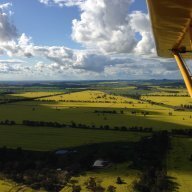-
Posts
1,032 -
Joined
-
Last visited
-
Days Won
13
About Roundsounds
- Birthday 25/12/1961
Information
-
Aircraft
Piper Cub
-
Location
NSW
-
Country
Australia
Recent Profile Visitors
The recent visitors block is disabled and is not being shown to other users.
Roundsounds's Achievements

Well-known member (3/3)
-
Bottom line is if you’re a private pilot and not based at or regularly operating from a Security Controlled airport get an AVID. You could argue any pilot who doesn’t have the need for an ASIC is breaking the law by obtaining one. When I have to pay for my own ASIC I’ll be switching to an AVID.
-
Roundsounds started following Terror aboard United Airlines Boeing 787 after pilot's screens went blank , Abolish ASIC , I Am A Member? But Really I Am A Shareholder? and 3 others
-
RAAus now RAWas
-

Small plane missing Victoria 18/09/22
Roundsounds replied to BrendAn's topic in Aircraft Incidents and Accidents
Just an acknowledgement would be ok -

Small plane missing Victoria 18/09/22
Roundsounds replied to BrendAn's topic in Aircraft Incidents and Accidents
Get around to it shortly? It’s not like they didn’t know the outcome, should’ve had something out to members the day the report was released. Says a lot about the culture of the place. -

Small plane missing Victoria 18/09/22
Roundsounds replied to BrendAn's topic in Aircraft Incidents and Accidents
RAWas -

I Am A Member? But Really I Am A Shareholder?
Roundsounds replied to jackc's topic in Governing Bodies
It will be interesting to see what happens to the various office bearers over time. I’m not sure whether you’ve read the Coroner’s report? It seems some actions by office bearers were not in accordance with documented procedures. The issues of concern to the Coroner relate to action / (inaction?) once the question of validity of the pilot’s RPC came to light within the organisation. -
Your response simply reinforces my comments. You do not need to nor should judge / sense airspeed, particularly when below 100’ AGL, the effect of wind has resulted in many low level stalls by mistaking ground speed as airspeed. You need to know the appropriate attitudes and power settings for various configurations and phases of flight. If they are set the airspeed will follow, no judgement required. I have logged over 6500 hours of flight instruction in tandem seating aeroplanes without ready access to flight instruments. This taught me to rely on attitude and airspeed, which I had been taught but really only made sense when that’s all I had. Students would often look around and ask where my ASI, ALT, Tacho were hidden as I was able to fly so accurately - nothing to with any special skills, just because I was flying visually attitude and setting power by ear. Until you are actively taught these skills you won’t develop them. You should be setting the appropriate power and attitude for the phase of flight, allow them to take effect, trim, then check airspeed. I’ll guarantee your backup ASI uses a common pitot / static source, so will only display same invalid reading. Most errors are the caused by a fault in the pitot / static system.
-
You’ve totalled missed the point! if you set the appropriate configuration and the appropriate attitude and power setting, airspeed will be correct - no need for an ASI. You’d be surprised as to the number of aeroplanes I’ve flown over the years with inaccurate ASIs. The typical problem being pin holes in the pitot or static lines.
-
I agree with the excess of technology, not necessarily about the effect of age. The basic stick and rudder skills are best taught with minimal instrumentation. This forces trainees to rely on visual attitudes rather than a PFD. When I had my flying school we operated one basic trainer without a VSI, DI or AH, it was ideal for the initial training. You need to establish those basic skills, then build on them. i would not send a student solo until they could complete a circuit with the instrument panel covered. You can see attitudes, hear power settings and judge height way more reliably than expected if trained to do so.




